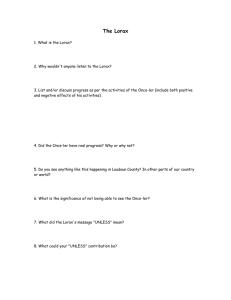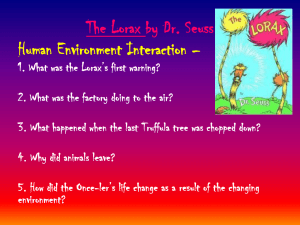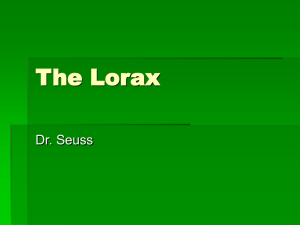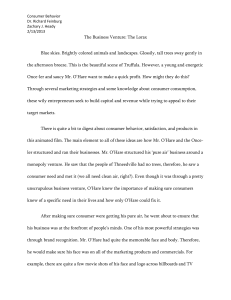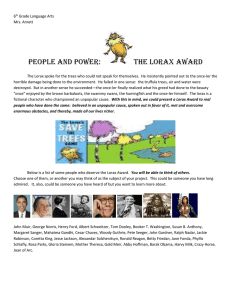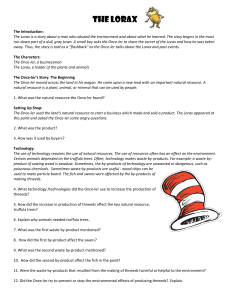The Lorax - Industrial revolution introduction
advertisement
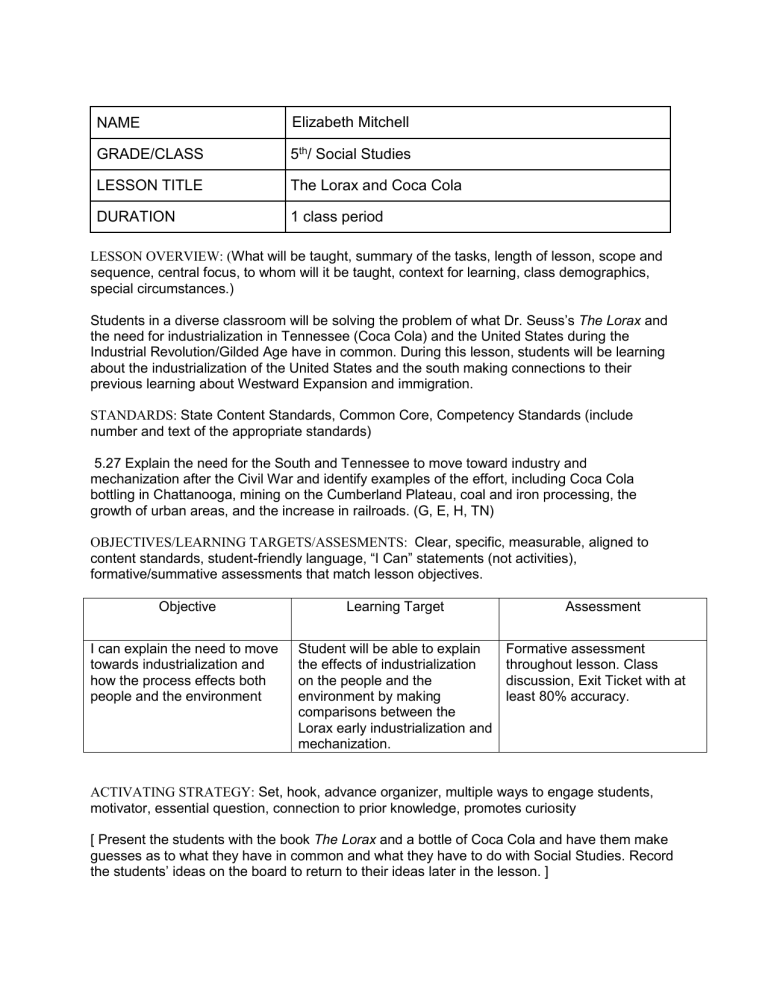
NAME Elizabeth Mitchell GRADE/CLASS 5th/ Social Studies LESSON TITLE The Lorax and Coca Cola DURATION 1 class period LESSON OVERVIEW: (What will be taught, summary of the tasks, length of lesson, scope and sequence, central focus, to whom will it be taught, context for learning, class demographics, special circumstances.) Students in a diverse classroom will be solving the problem of what Dr. Seuss’s The Lorax and the need for industrialization in Tennessee (Coca Cola) and the United States during the Industrial Revolution/Gilded Age have in common. During this lesson, students will be learning about the industrialization of the United States and the south making connections to their previous learning about Westward Expansion and immigration. STANDARDS: State Content Standards, Common Core, Competency Standards (include number and text of the appropriate standards) 5.27 Explain the need for the South and Tennessee to move toward industry and mechanization after the Civil War and identify examples of the effort, including Coca Cola bottling in Chattanooga, mining on the Cumberland Plateau, coal and iron processing, the growth of urban areas, and the increase in railroads. (G, E, H, TN) OBJECTIVES/LEARNING TARGETS/ASSESMENTS: Clear, specific, measurable, aligned to content standards, student-friendly language, “I Can” statements (not activities), formative/summative assessments that match lesson objectives. Objective Learning Target I can explain the need to move towards industrialization and how the process effects both people and the environment Student will be able to explain the effects of industrialization on the people and the environment by making comparisons between the Lorax early industrialization and mechanization. Assessment Formative assessment throughout lesson. Class discussion, Exit Ticket with at least 80% accuracy. ACTIVATING STRATEGY: Set, hook, advance organizer, multiple ways to engage students, motivator, essential question, connection to prior knowledge, promotes curiosity [ Present the students with the book The Lorax and a bottle of Coca Cola and have them make guesses as to what they have in common and what they have to do with Social Studies. Record the students’ ideas on the board to return to their ideas later in the lesson. ] INSTRUCTION: Strategies, learning tasks, big ideas, procedures, sequence, higher-order questioning, differentiation, active student participation, guided and independent practice, descriptive academic feedback, academic language, modeling, problem solving, based on data and teacher knowledge of students [The teacher will read The Lorax to the students while reading, the teacher will stop to ask students what they noticed the Once-ler did once he knew his thneeds would sell Student responses: the fact that the Once-ler made factories and automated machines to do everything faster. He also employed more people to help him. He could sell more thneeds if he had a factory and more workers, and he made a larger profit. After reading, return to the initial question and see if students have new ideas. Ask students why the Once-ler made the choices that he did with his business. What factors made him choose to create the factory (looking for more people wanted thneeds and wanted to make more money) Students will record their information on a problem and solution graphic organizer. Students will then view part of the flocabulary video on the industrial revolution. Students will discuss the information from the video and add the new information to the problem solution graphic organizer. The teacher will ask the students to compare this to what happened with the Once-ler. Provide the students with the story of the first Coca Cola Bottling plant. Ask for student volunteers to read. After reading, students will complete the final blocks of their problem solution chart. The class will analyze the information and compare all three problems and solutions. Students should be able to note that both the Once-ler and Coca Cola began with one person and were expanded into larger factories. All three events had to do with needing more/faster. The teacher will then show pictures of the Coca Cola bottling plant and other factories during the early 1900s. The teacher will ask the student if they feel that the disadvantages of the onceler’s story were similar to those of these factories. Discuss with students if they believe the effects of these factories were acceptable or if the Once-ler and the factories should have tried to do things differently. Ask students if there were other ways the Once-ler and early industries could have produced their goods without the pollution. Ask students if they can make connections to what is happening today (businesses closing, pollution, etc) to what happened to the Once-ler Students will complete an exit ticket answering the question of why industrialization was necessary. Students should be able to identify the problems and solutions. MODIFICATIONS: Accommodations, modifications, support for diverse student learning needs, interventions, extensions, ELL, IEP, 504, differentiation, teacher knowledge of students Preferential Seating, reading aloud, additional prompts to begin tasks, Students in this class enjoy being read to and enjoy picture books. Visual, audio and text learning. GROUPING: Explain how grouping students assists in reaching lesson objectives [Students are grouped in mixed ability groups with ability and behavior in mind, students seated closer to teacher’s desk for behavior and additional supports. Students are in smaller groups to curb behaviors and aid in focus. ] MATERIALS / RESOURCES / TECHNOLOGY: Key instructional resources and materials to engage students in learning, aligned with lesson objectives and standards, how materials will support differentiation [ The Lorax by Dr. Seuss, copies of the History of Coca Cola, flocabulary video, images of early factories and cities.] CLOSURE: restate objective and teacher will facilitate a discussion using prior knowledge of the south during and after the Civil War. Ask students to list reasons why the industrial revolution was necessary and what the advantages of the industrialization were. Students will complete an exit ticket giving two reasons why the industrial revolution was necessary. Answers could include, more people, need more goods, more money and jobs.
